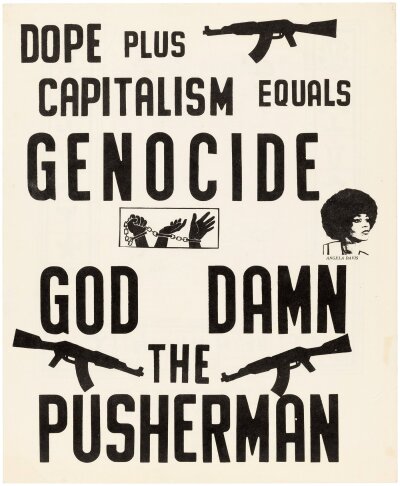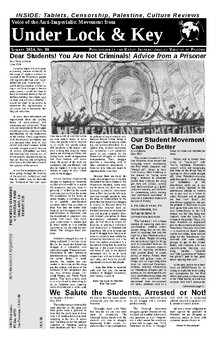
Black Religion in Michigan Prisons

Religion was part of the impetus that went into the creation of modern prisons in the United $tates of Amerika. With the opening of the Eastern State Penitentiary in 1829 in Philadelphia, the experiment of molding human behavior with confinement and a bible, the idea was isolation and self-reflection would lead to penitence and a corollary eradication of sin, or criminality. However, the seeding of religion within such a volatile atmosphere never took root as designed, but has nevertheless served a persisting role behind the walls, bars and fences of condemnation and incapacitation, with positive and negative consequences. This short article visits the phenomenon of Black religion as it occurs from a materialist perspective within the Michigan Department of Corrections (MDOC), and its implications relative to Black life inside and outside the walls.
Social organization within the MDOC is controlled by Black men from the enclaves of cities hosting large segments of Black denizens. Power dynamics on the prison yards were determined by crews and cliques from these enclaves, with the inhabitants of Detroit overwhelmingly determining the direction and atmosphere of the prison yard; but the power of crews and cliques would start to diminish as a result of the Black power movements of the 1960s and 70s which had serious implications on how social (power) dynamics would be reformed. This reshaped the inner prison structure within the MDOC.
The prison system witnessed an exodus of Blacks from Christianity into the bosom of Black Muslimhood (Islam) for many Black cons – often infused with a radicalism endemic of the times. As prisoners from the cross-section of Michigan cities with the largest Black neighborhoods adopted membership into religious organizations like the Moorish Science Temple of America (MSTA), Orthodox Islam, the Nation of Islam (NOI), and lastly the Melanic Palace (and Islamic Palace) of the Rising Sun (MPRS/MIPRS), the diversity of the crews/cliques coagulated into unions of these religious folds. The yard was now structured, for the most part, by these four religious blocs who set the rules of compliance and how prisoners related to the powers that be: prison guards and administrators.
These Black religions served multiple functions from individual protection and a greater collective security in the face of growing quantitative and qualitative changes characterized by violence; a sense of belonging; quasi-familyhood and a material support system, however loose; an avenue to educate oneself and engage in character edification for self-betterment; an alternative power base to offset, counter and resist the state agency of the MDOC and its forms of repression, oppression, and aggression typical of a white political body utilized to isolate, control and dominate potential Black rebels, societal dropouts, and the politicized elements capable of organizing and fomenting direct opposition to white racism and anti-Black hate and containment.
During the onset of the 1980s, the Melanic Islamic Palace of the Rising Sun caught fire with its inductee membership [soaring] to rival other Black religious groups. But what set the Melanic Islamic Palace apart was their willingness to inflict violence on prison guards and staff. This, too, would prove to have both positive and negative consequences. Positive in that energy was invested in degrees of political education and the building of a requisite consciousness steeped in Black nationalist rhetoric, which spilled over and was consumed primarily by the NOI, and to lesser degrees the MSTA and Orthodox Muslims. Negative in that the State, like any serious sociopolitical entity, started focusing attention on these groups which would later bloom into a tsunami of backlash and repression that would blast the political and radical elements out of MDOC religious groups, pushing them to take up a near exclusive God-centric and moralistic brand of religious practice.
The Melanics would eventually be repressed, banned from group service, and branded a security threat group which is tantamount to free society’s terrorist designation. The ripple effects of this move would fuel the aftershocks for decades to come to this very day. Political content and its verbiage are now nearly obsolete among the Black religious groups for fear of repression and possible banishment of group worship. Radical activism has not only largely died out, but can also be frowned upon by Black religious adherents. The yard structure and its rules based compliance has all but evaporated with exception of a few prisons. And with those older prisoners from the 1970s and 80s having returned to society, become frail seniors in prison or having died off, a leadership vacuum was opened to be filled by the incoming street gangs of the younger generation who would steer asunder the remaining residue of rule by structure. A by-product of this alteration in yard power has been that the Black religious groups have become old in age relative to its membership, have become socially and politically ineffective, and have reverted to existing as mere prison social groups who sometimes operate as prison yard gangs.
In the midst of the expiring decades in prison from the 1970s to the 2020s, the move towards Black Muslim-ism in prison has had some serious uninttended consequences, mainly, a lost and/or move away from Afrikanism (consciously and unconsciously). Plagued by anti-Afrikan bias as a result of post-slavery cultural, spiritual and mental colonialism (mentacide), with the exception of few, the Black Muslim groups argued instead for an Asiatic and/or Arab identity that didn’t require them to identify with the savage, barbarian, backward, uncivilized Africans who had no history and remained primitive, as their white masters had intentionally misinformed them during the breaking process of Afrikans to Niggas. And when/where a colonial based Blackness was expressed, unbeknownst to its propounders, it was delivered from a religious package that actually vitiated Blackness as it grew out of a Eurocentric conceptuality birthed during the Hellenistic epoch.
This contradictory pro-Black western (Eurocentric) religious conceptuality carries itself from behind the walls into open society as one of the nails in the coffin to serious liberation struggle advanced by Black people inside the imperialist center of North Amerika. Unfortunately, Black has proven to be ineffective as a sole basis for unity in this country as its nuanced nature cultures fragmentation, and Black western conceptualized religion only fuels the fractures of Blackness into an extreme polylithic substance that rejects a collective Black consciousness that’s bound for, or even focused on liberation.
But does there exist any light to dispel this dark period of irrelevant prison-religion utility? With the 2022 revision to the MDOC religious policy permitting the group service of the indigenous Afrikan Ifa spirituality, and the often radical Hebrew Israelite religion, one might argue the cusp of change is potentially present, and a new day may be dawning. However, I am not convinced. The perpetual distortion of indigenous Afrikan spirituality with western conceptuality spells doom to prospects of Black religion being utilized for liberation purposes. And like education, if a subject is not used for liberation, despite whatever radical nature it may acquire, and pro-Black or anti-white rhetoric it protest, its final product will prove to be a pro-Amerikan assimilationist one.
So the problem with Black religion in prison, speaking in the context of Blackness, no different than Black religious experience in the free world, is it’s devoid of power politics, is Eurocentric (laden with western [Hellenistic] concepts), and is reformist-integrationist-assimilationist (pro-Amerika). These three elements fight against the ability of the Black body to develop a monolithic character (collective consciousness), at least as it concerns Black unity as necessary for our capacity to adequately struggle for liberation or an activist model and mentality that is capable of loosening the screws and weakening the bricks of the prison complex structure.
Prison religion, or Black religion in general has made Karl Marx into a prophet where they serve to actualize his quote: “religion is the opium of the people.” And while I am certain over time many brothers within the MDOC will be exposed to Ifa and even grow to appreciate and practice it, no different than those brothers who have acquired knowledge about Kemeta, it will yet remain tethered to western monotheistic conceptuality through which brothers will be taught to practice it. In this way, it’ll be of little consequence as the receiving receptacles will fail to decolonize their minds of western conceptuality. Instead, the example of the Haitian revolutionaries must be followed by marrying our spirituality to struggle for power. Otherwise, Ifa will function as a mere symbol of Afrikanism, and brothers will be lying to themselves about being Afrikan-centered while actually promoting an inconsequential cultural nationalism that does absolutely nothing to foment a consciousness that could serve as models to alter prison conditions to their benefit. Ifa will be a mere badge of knowledge; a gold chain or Rolex shown off as a fetish, and will soon be denigrated to the margins of irrelevancy on par with the rest of black prison religions within the MDOC.
In my final analysis, drawing from more than two decades inside the cage, I conclude Black religion in the MDOC has been regressive. And contrary to some external beliefs outside the walls, Black prison-religion is not progressing towards Afrikan-based religious affiliation. Black Islamism is still the preferred go-to as it has successfully positioned itself as the popular vehicle for black intellectualism, freedom and expression of Black pride. In the end, however, Black religion in the MDOC is failing Black convicts and has betrayed and continues to betray authentic Black activism and struggle.





 Alabama
Alabama
 Alaska
Alaska
 Arizona
Arizona
 Arkansas
Arkansas
 Army Post
Army Post
 California
California
 Colorado
Colorado
 Connecticut
Connecticut
 Delaware
Delaware
 District of Columbia
District of Columbia
 Federal
Federal
 Florida
Florida
 Georgia
Georgia
 Guam
Guam
 Hawaii
Hawaii
 Idaho
Idaho
 Illinois
Illinois
 Indiana
Indiana
 Iowa
Iowa
 Kansas
Kansas
 Kentucky
Kentucky
 Louisiana
Louisiana
 Maine
Maine
 Maryland
Maryland
 Massachusetts
Massachusetts
 Michigan
Michigan
 Minnesota
Minnesota
 Mississippi
Mississippi
 Missouri
Missouri
 Montana
Montana
 Nebraska
Nebraska
 Nevada
Nevada
 New Hampshire
New Hampshire
 New Jersey
New Jersey
 New Mexico
New Mexico
 New York
New York
 North Carolina
North Carolina
 North Dakota
North Dakota
 Ohio
Ohio
 Oklahoma
Oklahoma
 Oregon
Oregon
 Pennsylvania
Pennsylvania
 Puerto Rico
Puerto Rico
 Rhode Island
Rhode Island
 South Carolina
South Carolina
 South Dakota
South Dakota
 Tennessee
Tennessee
 Texas
Texas
 Utah
Utah
 Vermont
Vermont
 Virginia
Virginia
 Washington
Washington
 West Virginia
West Virginia
 Wisconsin
Wisconsin
 Wyoming
Wyoming
